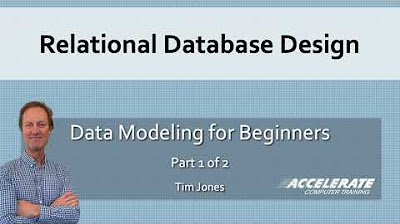Basic Entity Relationship Models
Summary
TLDRThis video introduces entity-relationship (ER) modeling, a way to design databases by mapping how data entities relate. It explains the basics of entities, attributes, and relationships, such as songs, artists, and albums, and how they interact through cardinalities like one-to-many or many-to-many. Concepts such as primary and super keys for uniquely identifying data, weak entities that depend on stronger entities, and participation constraints are discussed. Various notations for ER diagrams, including double ovals for multi-valued attributes and recursive relationships, are also covered to build a comprehensive data model.
Takeaways
- 📊 Entity-Relationship (ER) models are used to represent how different types of data relate to one another, focusing on the meaning (semantics) behind entities and their relationships.
- 📦 Entities, such as 'song', are represented as rectangles, while their attributes, like 'title' or 'artist', are shown in ovals.
- 🔑 Unique identifiers, or 'super keys', can be combinations of attributes, but it's often more efficient to use a single attribute as a 'primary key', like a song ID.
- 🎨 Some attributes can be composite, meaning they can be broken down into smaller elements, like 'duration' split into 'minutes' and 'seconds'.
- ♻️ Relationships between entities, such as between 'artist' and 'song', can be represented with diamonds, showing how entities interact, such as 'sings' or 'features'.
- 🔄 Cardinality indicates how entities relate in terms of numbers, such as 'one-to-many' or 'many-to-many' relationships, like an artist singing many songs, but each song having one main artist.
- 🛠 Some entities, like 'album' and 'artist', are modeled separately with their own attributes and relationships to other entities, allowing for complex data structures.
- 🔗 Total participation means an entity, like an album, must always have a relationship with at least one song, whereas partial participation allows for more flexibility.
- 🧩 Weak entities, such as a 'review', depend on a strong parent entity, like an 'album', for their existence, and this dependency can be modeled with special notations.
- 🔀 Complex relationships, such as ternary relationships (involving three entities), can be used to model interactions like 'purchase', where an album is sold by a seller to a customer.
Q & A
What is an Entity-Relationship (ER) model used for?
-An ER model is used to represent how different types of data relate to one another. It helps in visually organizing entities and their relationships within a database, showing how data is interconnected.
What does the term 'semantic model' mean in the context of an ER model?
-A semantic model conveys factual information about how different entities relate to one another. In an ER model, this refers to defining what it means to be an instance of each entity type and how these entities are interconnected.
What are the key symbols used in an ER model and what do they represent?
-In an ER model, entities are represented by rectangles, attributes by ovals, and relationships by diamonds. Cardinality (relationship size) and participation constraints are often indicated with lines and symbols like double lines or min-max notation.
How can attributes be differentiated from entities in an ER model?
-Attributes are generally depicted inside ovals and connected to their respective entities, while entities are shown as rectangles. Whether data is treated as an attribute or an entity depends on its importance and the model's intended use.
What is a composite attribute, and can you provide an example?
-A composite attribute is an attribute that can be broken down into smaller components. For example, a 'date' attribute can be broken down into 'day', 'month', and 'year'.
What is a super key, and how is it different from a primary key?
-A super key is a set of attributes that can uniquely identify an entity. A primary key is a specific super key chosen to be the main way to look up an entity. A primary key must be unique and minimal, meaning it contains no unnecessary attributes.
What is the purpose of defining relationships between entities in an ER model?
-Relationships in an ER model show how entities interact with one another. They define associations such as 'Artist sings Song' or 'Album contains Song', helping to clarify how data points are connected.
What is meant by cardinality in an ER model?
-Cardinality refers to the number of relationships that can exist between two entities. For example, in a one-to-many relationship, an artist can sing many songs, but each song can only be sung by one artist.
What is the difference between total and partial participation in relationships?
-Total participation means that every instance of an entity must participate in the relationship, indicated by a double line. Partial participation allows for the possibility that some instances do not participate, indicated by a single line.
How does the ER model handle weak entities, and what is their relationship with strong entities?
-Weak entities depend on a strong entity for their existence. They are depicted with double rectangles and have no primary key of their own, but instead rely on a relationship with the strong entity to be uniquely identified.
Outlines

このセクションは有料ユーザー限定です。 アクセスするには、アップグレードをお願いします。
今すぐアップグレードMindmap

このセクションは有料ユーザー限定です。 アクセスするには、アップグレードをお願いします。
今すぐアップグレードKeywords

このセクションは有料ユーザー限定です。 アクセスするには、アップグレードをお願いします。
今すぐアップグレードHighlights

このセクションは有料ユーザー限定です。 アクセスするには、アップグレードをお願いします。
今すぐアップグレードTranscripts

このセクションは有料ユーザー限定です。 アクセスするには、アップグレードをお願いします。
今すぐアップグレード関連動画をさらに表示

Lec-14: Introduction to ER model | ER Model क्या है

[BGD02B-ID] Entity Relationship (ER) Modelling

Bancos de Dados - Aula 04 – Modelo Entidade - Relacionamento estendido

Relational Database Design: Data Modeling for Beginners Part 1 of 2

Banco de Dados - Aula 13

Belajar Membuat ERD (Entity Relationship Diagram) | Belajar UML & Perancangan Sistem
5.0 / 5 (0 votes)
